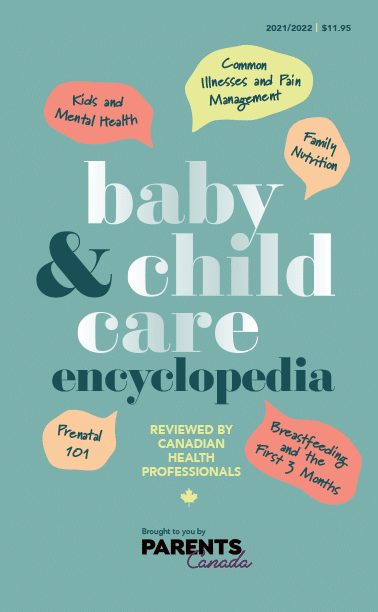Baby
14 min Read
Everything You Need To Know About Feeding Your Baby

October 29, 2021
Baby
14 min Read

October 29, 2021

From the pages of the Baby & Child Care Encyclopedia: Chapter 2, Breastfeeding and the First Three Months
m
New parents always ask how often babies should eat. The answer? Whenever they’re hungry. You’ll find you’re feeding on demand—that means you’re giving your babe what he or she needs when he or she needs it. This goes for whether you’re nursing or bottle-feeding. When your kiddo shows you those cues (fingers in the mouth, sucking noises, rooting and crying), it’s time to feed. Newborns generally eat every one to three hours. Breastfed babies vary in timing based on your milk supply, speed of letdown, how hungry they are and how fast they fall asleep, while formula-fed babies will eat two or three ounces at a time. Monitoring how much they eat is easy when you’re bottle-feeding, but it can be difficult when nursing. As long as he or she is wetting six diapers and pooping a couple times a day, it’s all good. If you have questions about your baby’s feeding schedule or you’re concerned about growth, your healthcare provider can help.
Breastfeeding You’ve no doubt heard breastfeeding’s many merits. Yes, what you’ve heard is true: Babies who nurse are usually less likely to get colds and flus; they’re less likely to have allergies; breastmilk is easy to digest, so babies get fewer digestive problems; it’s environmentally friendly and it’s always fresh and the right temperature. It’s also good for Mom: It helps the uterus go back to its pre-pregnancy shape quicker; it’s super convenient (no getting bottles ready or packing them up!); and it’s much cheaper than formula. What’s more, the Canadian Pediatric Society recommends that all babies be exclusively breastfed for the first six months.
All that said, we’re not going to sugar coat it—some women find breastfeeding difficult, unnatural and uncomfortable. But don’t worry, there are lots of tips and tricks to make it easier, starting with how to hold your baby while nursing.
BREASTFEEDING POSITIONS
SIDE-LYING POSITION: Mom lies on her side, stomach to stomach with Baby. Mom can cradle Baby with her arm, resting on the side supporting her breast properly with the other hand. Using the arm holding the baby, move the baby close enough to guide the breast to the mouth.
CRADLE: Baby is positioned across Mom’s abdomen so that the baby’s whole body faces the mother’s body and the baby’s head is supported by the mother’s arm. Baby’s lower arm is tucked around Mom’s waist. Baby’s ear, shoulder and hip should be in a straight line.
FOOTBALL: This works well for moms who’ve had a Caesarean birth or have flat or inverted nipples, as well as for small babies. Mom sits upright with pillows at her side. She supports the back of Baby’s neck with her hand, allowing Baby’s head to tilt back a little. Holding the breast, Mom tickles Baby’s lower lip and waits for the mouth to open.
CROSS-CRADLE: Mom sits upright with good back support and a pillow in front of her. Lie Baby across Mom’s body facing. She holds her breast with one hand and supports the back of Baby’s neck and shoulders with her other hand. This position works well for babies who have difficulty with latching.
What is Colostrum This is the liquid your baby gets for the first few days, before your milk comes in. It’s rich in vitamins, protein and substances that protect Baby from germs. This liquid gold is thicker than milk, more yellow in colour and babies often only take a little at a time so feed frequently.
Putting Baby to Breast When your baby starts to suckle, a message is sent to your brain to produce milk. The message is then sent to your breasts and hormones are released. Deep in your breast tissue are bunches of tiny, milk-making cells. These cells start to make milk.
At this point, your baby’s face should be facing your breast (not the ceiling) and the body should be in line. If you look down, his or her ears, tips of the shoulder and hip bone will be in a straight line. The neck shouldn’t be twisted. Baby’s nose should be across from your nipple. When you are holding your baby in a firm hold, you are in control. Baby is facing your breast with his or her mouth just below your nipple. Now you have to have patience and wait for a big mouth (yawns are always good here). Sometimes, touching Baby’s lips gently with your nipple may tease the mouth open. When you see that big mouth, very quickly push your baby onto your breast, aiming upwards and backwards at the roof of their mouth. Don’t try to push your nipple into the mouth, it will just get stuck at the front of the mouth and that will be painful.
When it comes to latching, you should notice his or her mouth will be filled with breast tissue so there’s no space left in the mouth. Place your nipple as far at the back of Baby’s mouth as possible. When you do this, your baby will be able to reach the part of your breast where the milk is, behind the areola (the brown part that surrounds the nipple). If you feel pain, it means Baby’s jaws are together on your nipple. If this keeps happening, expect your nipple to get super sore and possibly even bleed. It’s not easy to see what a proper latch looks like, but you can feel it. Your baby’s nose will be touching your breast and the lower jaw will be under your areola. Some mothers worry their babies aren’t able to breathe with a face full of breast, but if they have trouble breathing, they instinctively come off the breast on their own. If there’s pain, just take Baby off and try latching again. When you’re ready to switch breasts or need to take Baby off, put your (clean) finger into the side of his or her mouth to break the suction.
Is Baby Feeding Well? Once Baby is latched on, you’ll see little jaw movements. As your milk lets down, you will see the jaw rhythm change to big open-and-close movements. The movement can be seen right up to the top of the ears. As Baby swallows, you’ll hear those swallowing, gulping noises—it may be a small sound, like a soft “ka” in the back of the throat.
Later, as the milk has more volume, you can hear swallowing much more easily. You’ll also notice a pattern of suckling when he or she is feeding—suck, swallow, suck, swallow, pause, repeat. This pattern continues throughout the feed. Infants usually come off the breast by themselves or fall asleep. Now’s the time to burp Baby and move to the second breast.
Length and Frequency of Feeding Moms used to be told to time their babies at the breast. We now know that babies will tell us when they’re ready to swap. Letting babies feed at the first breast for as long as they want allows them to get lots of that good high-fat milk (hindmilk). Don’t worry if Baby doesn’t feed for long when on the second breast, or if he or she doesn’t want the second breast at all. Start with that side next time you feed.
Breastmilk is easily digested, and new babies have small tummies. They may want to feed every 90 minutes to three hours during the day, and every three to four hours at night. The pattern will change as the weeks go by. As the baby grows and your breasts become better at what they are doing, he or she will take more milk and last longer between feeds. The best signs to look for that babies are getting enough milk are if they’re soaking six to eight diapers a day by the second week; if they’re doing at least one big poop a day; if they appear content between feeds; and if their clothes start getting a bit snug.
Changes in Your Milk By about the third day of nursing, your milk changes. The milk that comes in has more water than colostrum, so your breasts will feel fuller. (Feeding frequently prevents engorgement, which helps prevent that super-full feeling.) Within about two weeks, your milk changes again into mature milk and continues changing to meet the baby’s needs while you are breastfeeding.
Baby’s Growth Spurts Babies seem to want to feed more often at about three weeks and six weeks, then again at three months and six months. If you notice your baby wanting to feed more often, or being fussy around these milestones, just feed more often. Your milk supply will catch up to the demand quickly.
Breast Care Showering daily is enough—you don’t need to do anything special to care for your breasts while nursing. You’ll want to avoid putting soap on your nipples, as it might make them dry. Special creams and lotions are not needed, though you might opt to use nipple cream for sore or dry nipples. Also, avoid wearing a tight-fitting bra and, if you’re comfortable, go braless at night
Breast Pain Pain in your breast tissue is likely due to a blocked duct—the result of milk left in a duct. If you feel the painful area with your fingers, you may notice a lump. Warm compresses and massage should clear it. You’ll also want to check that your positioning and latch are good when nursing.
If you see redness in your breast and start having flu-like symptoms, call your healthcare provider or lactation consultant as you may have an infection known as mastitis. Pain felt deep in the breast during let down or after a feed is often due to the muscle lining of the ducts being stretched as the milk passes through. Again, try warm compresses; this pain often goes away as time goes by.
If you feel burning or stabbing pain in the nipple or breast, thrush is likely the culprit. You might also see small white spots in your baby’s mouth—that’s because thrush is passed from Baby to Mom and Mom to Baby. You’ll need to see your doctor and get treatment for your nipples, as well as treatment for the baby.
Engorgement Engorgement usually happens around the third day. It’s normal to feel a sense of fullness in your breasts as your milk increases in volume. (There’s also extra blood and other body fluids moving into the area that adds to the fullness.) The best thing you can do is feed your baby as much as possible when engorged.
If your breasts feel really full, it may be hard for your baby to latch onto the areola. If this is the case, you can express some milk in order to soften the area around your nipples. If you can’t put your baby to breast, use an electric pump to keep your breasts soft. Pump every two to three hours and save the breastmilk for your baby.
The truth is, some moms always feel engorged, no matter what they do. It’s not super fun when your breasts become rock hard. Consider using warm compresses and gentle massaging, as well as expressing.
Mom’s Diet First things first—there are no foods you need to avoid when breastfeeding. (Yes, order that sushi!) That said, if you find your baby gets fussy every time you eat a certain food, avoid it for a while, then try it again in a few weeks. To supply the energy and nutrients needed for breastfeeding, you just need to follow Canada’s Food Guide to Healthy Eating. And drink water and other fluids according to how thirsty you are. Don’t feel that you have to force yourself to drink.
Breastmilk Storage You can keep breastmilk in the fridge for up to five days. When storing milk for freezing, it will keep well in a freezer compartment in the fridge for two weeks; in a self-contained freezer unit for up to four months; and in a deep freeze at zero degrees for six months or longer. Don’t forget to label and date all milk.
Support While many women say breastfeeding feels totally natural, other moms report feeling the opposite—it doesn’t feel easy or “normal” for many of us. If you’re having a tough time and want to keep nursing, there are plenty of ways to get help. Finding another mother—a friend or family member—who’s recently experienced nursing is a good starting point. Many communities have a support network, so you can call your local health department, La Leche League or look for a lactation consultant online.
Bottle-Feeding Contrary to what you might’ve heard, infant formula is a great alternative to breastmilk for babies—it’s nutritious and babies thrive on formula, growing nice and healthy. If this is the route you choose, you’ll find that all products with the words “infant formula” on the label provide enough nutrition for your baby—today they’re made to be as close to breastmilk as possible.
How to Formula Feed Bottle-feeding can give Mom just as much bonding time as nursing, and it can also let Dad, grandparents, etc., have that special time too.
Hold Baby close, keeping his or her back and neck straight. Baby’s head should be tipped back slightly and held higher than her body so that formula doesn’t get into her inner ear when she swallows. Brush the nipple against his or her lips or cheeks. Hold the bottle on an angle so that the nipple is always full of milk and so that Baby doesn’t suck in air.
When everything is going well, Baby will suck and swallow easily without coughing, gagging or coming off the bottle to cry. If you see any of these behaviours, stop feeding and check the nipple—milk might be pouring out too quickly or too slowly. It’s totally normal for babies to spit up a little formula during or after a feeding. Burp after feeding.
| BABY’S AGE | FEEDINGS PER DAY | AMOUNT OF FORMULA |
| 1 to 2 weeks | 6 to 10 | 50 to 100 ml (2 to 3 oz) |
| 3 to 8 weeks | 6 to 10 | 125 to 150 ml (4 to 5 oz) |
| 2 to 3 months | 5 to 6 | 150 to 175 ml (5 to 6 oz) |
| 3 to 4 months | 4 to 5 | 175 to 210 ml (6 to 7 oz) |
| 5 to 7 months | 4 to 5 | 210 to 250 ml (7 to 8 oz) |
| 8 to 12 months | 3 | 210 to 250 ml (7 to 8 oz) |
How to Know When Your Baby Has Had Enough Formula Babies will let parents know when they’re done—they simply stop feeding when they’re full. Your babe has had enough when sucking slows, when he or she turns his or her head away or when he or she falls asleep. In time you’ll learn your little one’s signs and you’ll be confident knowing he or she has eaten enough. Throw out any formula left in the bottle within one hour after the feeding begins and don’t reheat the milk.
Storing Formula Keep prepared bottles at the back of the fridge and use them within 24 hours. Open cans of powder should be used within one month, while refrigerated cans of liquid concentrate and ready-to-feed formula need to be used within 24 hours of opening. Do not freeze any kind of formula because it changes the fat content.
